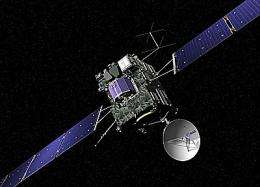The most important alarm clock in the Solar System (w/ Video)

At 10:00 GMT on Monday, the most important alarm clock in the Solar System will wake up ESA's sleeping Rosetta spacecraft.
Rosetta is chasing comet 67P/Churyumov–Gerasimenko and, since its launch in 2004, has made three flybys of Earth and one of Mars to build up enough speed and get on a trajectory towards the comet. It has also encountered asteroids Steins and Lutetia along the way.
Operating on solar energy alone, the spacecraft was placed into a deep space slumber in mid-2011 as it cruised far from the Sun and out towards the orbit of Jupiter. To prepare for its long sleep, Rosetta was oriented so that its solar arrays faced the Sun and put into a once per minute spin for stability.
The only devices left running were its computer and several heaters.
Thirty-one months later, Rosetta's orbit has brought it back to within 'only' 673 million kilometres of the Sun, and there is finally enough solar energy to power the spacecraft fully again. It is time to wake up.
Rosetta's computer is programmed to carry out a sequence of events to re-establish contact with Earth on 20 January, starting with an 'alarm clock' at 10:00 GMT.
Immediately after, the spacecraft's startrackers will begin to warm up, taking around six hours.
Then its thrusters will fire to stop the slow rotation. A slight adjustment will be made to Rosetta's orientation to ensure that the solar arrays are still facing directly towards the Sun, before the startrackers are switched on to determine the spacecraft's attitude.
Once that has been established, Rosetta will turn directly towards Earth, switch on its transmitter and point its high-gain antenna to send its signal to announce that it is awake.
Because of Rosetta's vast distance – just over 807 million kilometres from Earth – it will take 45 minutes for the signal to reach the ground stations. The first opportunity for receiving a signal on Earth is expected between 17:30 GMT and 18:30 GMT.
Deep space tracking dishes will be listening out for the signal, starting with NASA's 'big ears' – the 70 m-diameter station at Goldstone, California, followed by, as the Earth rotates, the Canberra station in eastern Australia. ESA's New Norcia 35 m antenna, in Western Australia, would be next in line to await the signal's arrival.
Whenever the signal is received, it will be relayed immediately to ESOC, ESA's Operations Centre in Darmstadt, Germany.
Provided by European Space Agency





















